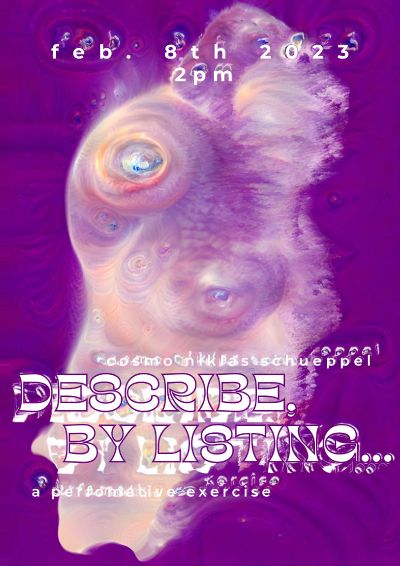| (31 intermediate revisions by the same user not shown) | |||
| Line 1: | Line 1: | ||
== | == '''Describe, by listing…''' == | ||
''( | All space, natural or human-made, is comprised of actors that fulfil actions. In the contemporary western world view, non-human and non-sentient (objects) actors are often reduced to their effect to humans. This is how we define their ‘function’. | ||
Through the interplay between these ‘functions’ humans ascribe ‘meaning’ to a space. Most of the time, we are unaware of the exact functions and relationships between these actors - and the meaning we are projecting into them. | |||
The participatory Performance ‘Describe, by listing…’ sets out to guide the participants into an awareness about these relationships. By asking the participants to describe their surroundings, the performative exercise goes back to the basics of human perception and meaning-making. Starting with simple descriptions, the exercise builds up gradually - to ultimately dive deep into the topics of subject/object-relationships, differences between function and meaning, and into a pictorial understanding of the interactions that exist in every space. | |||
The exercise can be done in any space, the content might change, but the experience is universal. A space outside is preferable. | |||
The performance is conducted, as follows: After welcoming words, the participators are asked to start a voice memo on their phones. The act of recording the voice helps to focus the attention while describing. The performer sounds a gong and gives the first instruction: “Describe, by listing: What do you see?”. The participants turn into their perception and start describing. | |||
Question after question they sink deeper into details of the space - focusing on different layers of the space and themselves: Interactions, consequences, function, meaning. | |||
They are entering into a meditation on the complexity of relationship patterns and are beginning to feel themselves being united with the other actors in the space. They may see memories rising up, morphing with the trees surrounding them. They may see the logical mind coming to its limits, and are being left in a silent awareness of their detailed perceptions. They may not find truth and meaning, but they experience what it means to search for the absolute. | |||
Performance is set to take place on '''Feb 8th 2023''' in '''Ilmpark''', Weimar. | |||
[[File:describe, by listing... POSTER.jpg|400px]] | |||
Words of the performance.doc (spoken out to the participators): | |||
[[:File:07.02.23decribe, by listing... performance script.pdf]] | |||
Edit of a participants recordings (test Performance 17.01.23, Berlin, Jahn-Sport-Park) | |||
https://soundcloud.com/cosmo-schueppel/describe-by-listing-audio-documentation/s-1PVmXl2hH6n | |||
'' | [[''concept state of 16.01.2023'']] | ||
[[''concept state of 01.12.2022'']] | |||
[[''concept state of 08.01.2023'']] | |||
---- | |||
old idea (contiued in Migas class) | |||
== '''not all who die are gone''' == | |||
[[''project documentation'']] | |||
Detailed process documentation on: | |||
''https://www.uni-weimar.de/kunst-und-gestaltung/wiki/GMU:Sustainable_Aesthetics/Cosmo_Niklas_Sch%C3%BCppel'' | |||
---- | |||
Latest revision as of 09:54, 7 February 2023
Describe, by listing…
All space, natural or human-made, is comprised of actors that fulfil actions. In the contemporary western world view, non-human and non-sentient (objects) actors are often reduced to their effect to humans. This is how we define their ‘function’.
Through the interplay between these ‘functions’ humans ascribe ‘meaning’ to a space. Most of the time, we are unaware of the exact functions and relationships between these actors - and the meaning we are projecting into them.
The participatory Performance ‘Describe, by listing…’ sets out to guide the participants into an awareness about these relationships. By asking the participants to describe their surroundings, the performative exercise goes back to the basics of human perception and meaning-making. Starting with simple descriptions, the exercise builds up gradually - to ultimately dive deep into the topics of subject/object-relationships, differences between function and meaning, and into a pictorial understanding of the interactions that exist in every space.
The exercise can be done in any space, the content might change, but the experience is universal. A space outside is preferable.
The performance is conducted, as follows: After welcoming words, the participators are asked to start a voice memo on their phones. The act of recording the voice helps to focus the attention while describing. The performer sounds a gong and gives the first instruction: “Describe, by listing: What do you see?”. The participants turn into their perception and start describing.
Question after question they sink deeper into details of the space - focusing on different layers of the space and themselves: Interactions, consequences, function, meaning.
They are entering into a meditation on the complexity of relationship patterns and are beginning to feel themselves being united with the other actors in the space. They may see memories rising up, morphing with the trees surrounding them. They may see the logical mind coming to its limits, and are being left in a silent awareness of their detailed perceptions. They may not find truth and meaning, but they experience what it means to search for the absolute.
Performance is set to take place on Feb 8th 2023 in Ilmpark, Weimar.
Words of the performance.doc (spoken out to the participators):
File:07.02.23decribe, by listing... performance script.pdf
Edit of a participants recordings (test Performance 17.01.23, Berlin, Jahn-Sport-Park)
https://soundcloud.com/cosmo-schueppel/describe-by-listing-audio-documentation/s-1PVmXl2hH6n
''concept state of 16.01.2023''
''concept state of 01.12.2022''
''concept state of 08.01.2023''
old idea (contiued in Migas class)
not all who die are gone
Detailed process documentation on:
